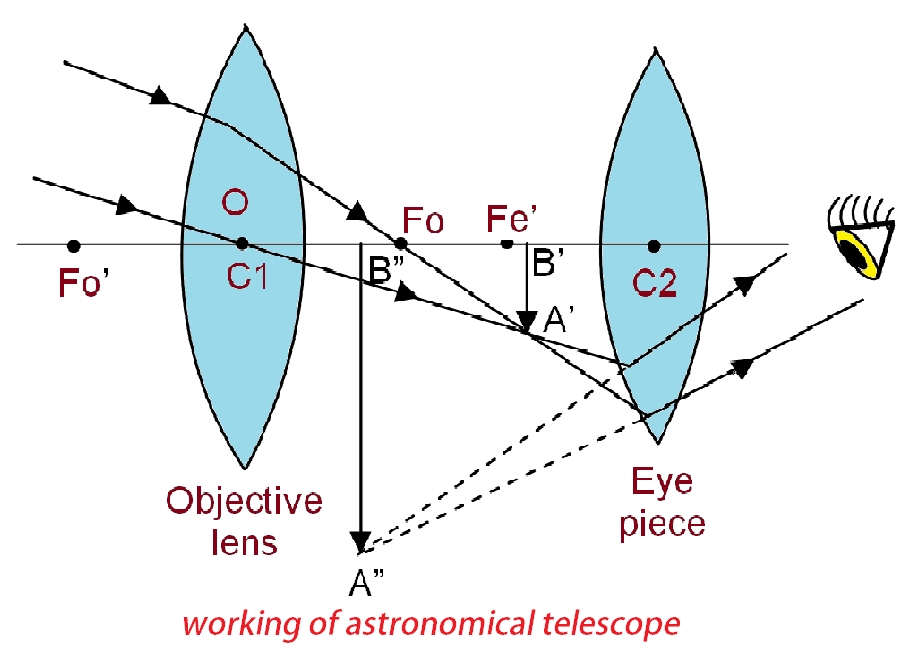
The final image formed by an astronomical telescope is:
A. real and erect
B. virtual and erect.
C. real and inverted
D. virtual and inverted
Answer
568.5k+ views
Hint: Astronomical telescope is an instrument that is a set-up of 2 or more optical lenses. A basic module of an astronomical telescope has 2 convex lenses named as objective lenses and eyepieces. Images formed by the complex mirrors are real images. When the rays of light come from a very far point (infinity) an inverted image can be obtained by a convex lens.
Complete answer:
Before going into the question we should know what an astronomical telescope actually is and what it looks like. So, basically a simple module of an astronomical telescope is an instrument of 2 convex lenses which are arranged in such a way that they magnify the distinct astrological objectives.
One of the lenses is known as an objective lens and the other is referred to as an eyepiece. Eye piece is comparatively smaller in size than the objective lens. The objective lens have h very have focal length.

The objective lens and the eyepiece are coordinately paced in such a way that the focal point of the objective comes between the focal length of the eye piece. The above diagram represents the working of the astronomical telescope. Where the light rays coming at the objective lens converge at its focal point after the refraction. As a result of this first refraction a real inverted image A’B’ is formed between the focal length of the eyepiece. This image magnifies with the help of the eye piece and a real inverted magnified image is formed behind the focus point of the eye piece A”B”. This is the final image which we are able to see through the astronomical telescope.
Now, it is asked in the question what would be the nature of the image formed by the astronomical telescope. From the above explanation we can conclude very clearly that the nature of the image will be real and inverted.
So, the correct answer is “Option C”.
Note:
Keep in mind that the telescope can have more than 2 optical lenses that depend on the resolution of the instrument. Here we have considered a basic module of the telescope. In all the telescopes the image formed will real in inverted only.
Complete answer:
Before going into the question we should know what an astronomical telescope actually is and what it looks like. So, basically a simple module of an astronomical telescope is an instrument of 2 convex lenses which are arranged in such a way that they magnify the distinct astrological objectives.
One of the lenses is known as an objective lens and the other is referred to as an eyepiece. Eye piece is comparatively smaller in size than the objective lens. The objective lens have h very have focal length.

The objective lens and the eyepiece are coordinately paced in such a way that the focal point of the objective comes between the focal length of the eye piece. The above diagram represents the working of the astronomical telescope. Where the light rays coming at the objective lens converge at its focal point after the refraction. As a result of this first refraction a real inverted image A’B’ is formed between the focal length of the eyepiece. This image magnifies with the help of the eye piece and a real inverted magnified image is formed behind the focus point of the eye piece A”B”. This is the final image which we are able to see through the astronomical telescope.
Now, it is asked in the question what would be the nature of the image formed by the astronomical telescope. From the above explanation we can conclude very clearly that the nature of the image will be real and inverted.
So, the correct answer is “Option C”.
Note:
Keep in mind that the telescope can have more than 2 optical lenses that depend on the resolution of the instrument. Here we have considered a basic module of the telescope. In all the telescopes the image formed will real in inverted only.
Recently Updated Pages
Master Class 12 Social Science: Engaging Questions & Answers for Success

Master Class 12 Physics: Engaging Questions & Answers for Success

Master Class 12 Maths: Engaging Questions & Answers for Success

Master Class 12 Economics: Engaging Questions & Answers for Success

Master Class 12 Chemistry: Engaging Questions & Answers for Success

Master Class 12 Business Studies: Engaging Questions & Answers for Success

Trending doubts
What are the major means of transport Explain each class 12 social science CBSE

Which are the Top 10 Largest Countries of the World?

Draw a labelled sketch of the human eye class 12 physics CBSE

How much time does it take to bleed after eating p class 12 biology CBSE

Explain sex determination in humans with line diag class 12 biology CBSE

Explain sex determination in humans with the help of class 12 biology CBSE




